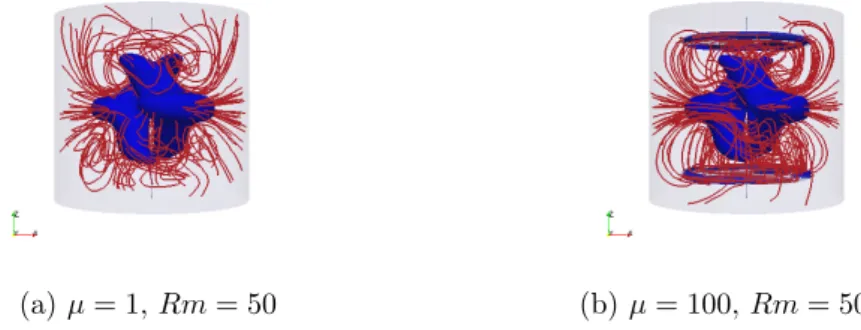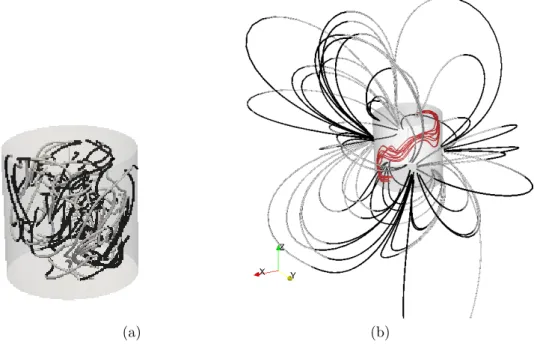HAL Id: hal-00600304
https://hal.archives-ouvertes.fr/hal-00600304
Submitted on 14 Jun 2011
HAL is a multi-disciplinary open access
archive for the deposit and dissemination of
sci-entific research documents, whether they are
pub-lished or not. The documents may come from
teaching and research institutions in France or
abroad, or from public or private research centers.
L’archive ouverte pluridisciplinaire HAL, est
destinée au dépôt et à la diffusion de documents
scientifiques de niveau recherche, publiés ou non,
émanant des établissements d’enseignement et de
recherche français ou étrangers, des laboratoires
publics ou privés.
Dynamo action in finite cylinders
Caroline Nore, J.-L. Guermond, Jacques Léorat, F. Luddens
To cite this version:
Caroline Nore, J.-L. Guermond, Jacques Léorat, F. Luddens. Dynamo action in finite cylinders.
EUROMECH Colloquium 525 - Instabilities and transition in three-dimensional flows with rotation,
Jun 2011, Ecully, France. �hal-00600304�
EUROMECH Colloquium 525, 21–23 June 2011, ´Ecully, France
Instabilities and transition in three-dimensional flows with rotation
DYNAMO ACTION IN FINITE CYLINDERS
C. Nore
1, J.-L. Guermond
1,2, J. L´
eorat
3& F. Luddens
1,21
LIMSI, CNRS, UPR3251, BP 133, 91403 Orsay cedex, France, Universit´
e Paris-Sud 11 and
Institut Universitaire de France.
2
Department of Mathematics, Texas A&M University, College Station, TX 77843-3368, USA.
3Luth, Observatoire de Paris-Meudon, place Janssen, 92195-Meudon, France.
Motivation
Using numerical simulations, we investigate two magnetohydrodynamics (MHD) problems in a cylindrical cavity, namely the von K´arm´an Sodium (VKS) experiment and a precessing cylinder filled with a conducting fluid. We use a parallel code denoted SFEMaNS [1], which is able to integrate nonlinear MHD equations for incompressible fluids in heterogenous domains (with jump distributions of electrical conductivity or magnetic permeability) with axisymmetric interfaces embedded in a vacuum. We numerically demonstrate that using high permeability disks in VKS decreases the dynamo threshold and that precession is able to drive a cylindrical dynamo.
1
Impact of soft iron impellers in the VKS dynamo experiment
The VKS experiment [2] leads to dynamo action, at the available power, using soft iron impellers but not using steel impellers. This demonstrates the crucial role played by ferromagnetic material that numerical studies can handle on simplified configurations. Therefore kinematic simulations of the induction equation (with imposed velocity field) are carried out for different setups suitable for this experiment. The impellers are modeled by flat disks of high conductivity or high permeability and drive the flow in a cylinder filled with a conducting fluid. Ohmic decay and kinematic dynamo problems using various configurations and physical parameters are investigated. The material properties of the disks change drastically the field geometry and growth rates while external boundary conditions have nearly no influence. Using a VKS like mean fluid flow and high permeability disks decreases the critical magnetic Reynolds number Rmc for the onset of dynamo action of the simplest non-axisymmetric field mode and confines the magnetic field lines in between the two ferromagnetic disks (see figure 1). In contrast, using high conducting disks increases Rmc. From the experimental point of view the utilization of disks with a conductivity that is 100 times larger than the conductivity of liquid sodium remains purely academic. Nevertheless, the simulations show a crucial difference between heterogeneous permeabilities and conductivities: even if these two quantities may appear in the definition of an effective Reynolds number Rmeff = µ
0µeffr σeffU L, they do not play the same role [3]. Increasing the permeability of the disks increases
(a) µ = 1, Rm = 50 (b) µ = 100, Rm = 50
Figure 1: Magnetic lines and iso-value of the magnetic energy density corresponding to 25% of the maximum magnetic energy for two disks with different magnetic permeability µ.
the decay time of the axisymmetric mode, especially the toroidal mode when permeability is high enough. It may thus appear as the dominant mode of the dynamo when the flow axisymmetry is broken, as it seems to be observed in the VKS experiment.
2
Dynamo action in a precessing cylinder
The possible contribution of precession to dynamo action is a long-standing debate (see for example [4]). Modern astrophysical observations of some planetary dynamos can contribute to resolving this issue, although definite
EUROMECH Colloquium 525, 21–23 June 2011, ´Ecully, France
Instabilities and transition in three-dimensional flows with rotation
evidence is still lacking. Because of the large computing resources required, it was only recently that numerical computations could demonstrate that dynamo action occurs in two different precessing containers: spherical [5] and spheroidal [6] ones. Since neither shape is convenient for large-scale experiments, it is instructive to investigate whether similar results can be obtained in cylindrical containers. Five parameters govern the flow: the aspect ratio of the container, the precession angle and precession rate (forcing parameters), and the kinetic and magnetic Reynolds numbers (fluid parameters, Re and Rm). Choosing the container length equal to its diameter, a precession axis orthogonal to the rotation axis and a precession rate of 0.15, the non-magnetic flow breaks its central symmetry when the kinetic Reynolds number becomes large enough (Re ≥ 103). The
nonlinear MHD problem starts after a small magnetic seed field is added. When the magnetic dissipation is small enough, i.e. for magnetic Reynolds numbers Rm above a critical value Rmc(Re), dynamo action appears after symmetry breaking of the flow, as was also observed in the spherical and spheroidal dynamos. A snapshot of a dynamo run shows the complex fluid flow in the container and the spatial distribution of the magnetic field lines in the cylinder and the vacuum. An experimental approach could be relevant to natural dynamos and seems within reach using a cylindrical container (cf. DRESDYN proposal in Germany, F. Stefani, personal communication).
(a) (b)
Figure 2: Snapshot of a dynamo run at Re = 1200, Rm = 2400 showing (a) internal magnetic field lines in the cylinder cavity, colored by the axial component vorticity (grey/black for positive/negative axial component) and (b) vorticity field lines (red) in the container and external magnetic field lines colored by the axial component. The cylinder is seen from the side, the Oz (respectively Ox) axis is the rotation (respectively precession) axis.
References
[1] J.-L. Guermond, R. Laguerre, J. L´eorat and C. Nore, Nonlinear magnetohydrodynamics in axisymmetric heterogeneous domains using a Fourier/finite element technique and an interior penalty method, J. Comput. Phys., 228:2739–2757, 2009.
[2] R. Monchaux, M. Berhanu, M. Bourgoin, M. Moulin, Ph. Odier, J.-F. Pinton, R. Volk, S. Fauve, N. Mordant, F. P´etr´elis, A. Chiffaudel, F. Daviaud, B. Dubrulle, C. Gasquet, L. Mari and F. Ravelet, Generation of a magnetic field by dynamo action in a turbulent flow of liquid sodium Phys. Rev. Lett., 98, 044702 (2007). [3] A. Giesecke , C. Nore, F. Luddens, F. Stefani, G. Gerbeth, J. L´eorat and J.-L. Guermond, Electromagnetic
induction in non-uniform domains, Geophys. Astrophys. Fluid Dyn., 1029-0419, 104:505–529, 2010.
[4] W. V. R. Malkus, Precession of the Earth as the cause of geomagnetism: Experiments lend support to the proposal that precessional torques drive the Earth’s dynamo, Science, 160(3825):259–264, 1968.
[5] A. Tilgner, Precession driven dynamos, Phys. Fluids, 17(3):034104, 2005.
[6] C.-C. Wu and P. Roberts, On a dynamo driven by topographic precession, Geophys. Astrophys. Fluid Dyn., 103(6):467–501, 2009.

